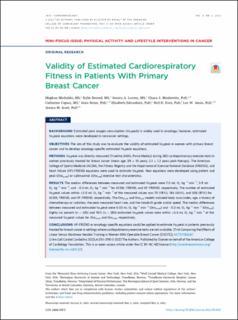| dc.description.abstract | Background: Estimated peak oxygen consumption (Vo2peak) is widely used in oncology; however, estimated Vo2peak equations were developed in noncancer settings.
Objectives: The aim of this study was to evaluate the validity of estimated Vo2peak in women with primary breast cancer and to develop oncology-specific estimated Vo2peak equations.
Methods: Vo2peak was directly measured (TrueOne 2400, Parvo Medics) during 380 cardiopulmonary exercise tests in women previously treated for breast cancer (mean age: 59 ± 10 years; 3.1 ± 1.2 years post-therapy). The American College of Sports Medicine (ACSM), the Fitness Registry and the Importance of Exercise National Database (FRIEND), and heart failure (HF)-FRIEND equations were used to estimate Vo2peak. New equations were developed using patient and peak (Oncpeak) or submaximal (Oncsub) exercise test characteristics.
Results: The median differences between measured and estimated Vo2peak were 7.0 mL O2·kg−1·min−1, 3.9 mL O2·kg−1·min−1, and −0.2 mL O2·kg−1·min−1 for ACSM, FRIEND, and HF-FRIEND, respectively. The number of estimated Vo2peak values within ±3.5 mL O2·kg−1·min−1 of the measured values was 70 (18%), 164 (43%), and 306 (81%) for ACSM, FRIEND, and HF-FRIEND, respectively. The Oncpeak and OncSub models included body mass index, age, a history of chemotherapy or radiation, the peak measured heart rate, and the treadmill grade and/or speed. The median differences between measured and estimated Vo2peak were 0.02 mL O2·kg−1·min−1 (Oncpeak) and −0.2 mL O2·kg−1·min−1 (Oncsub). Eighty-six percent (n = 325) and 76% (n = 283) estimated Vo2peak values were within ±3.5 mL O2·kg−1·min−1 of the measured Vo2peak values for Oncpeak and Oncsub, respectively.
Conclusions: HF-FRIEND or oncology-specific equations could be applied to estimate Vo2peak in patients previously treated for breast cancer in settings where cardiopulmonary exercise tests are not available. (Trial Comparing the Effects of Linear Versus Nonlinear Aerobic Training in Women With Operable Breast Cancer [EXCITE]; NCT01186367 | en_US |
